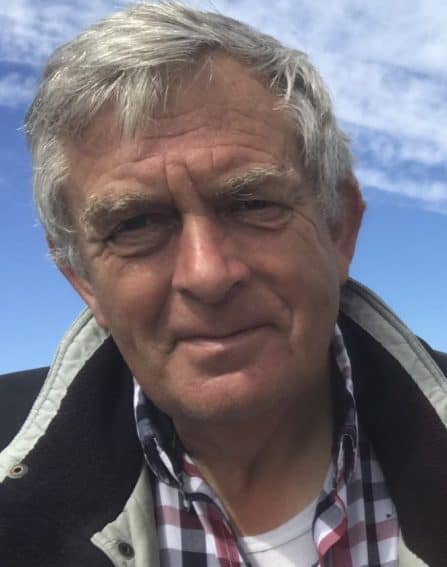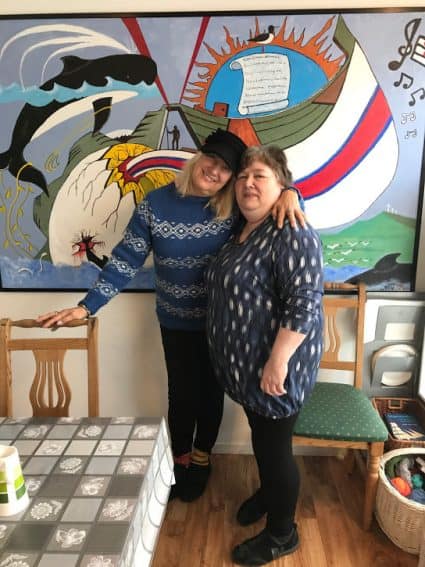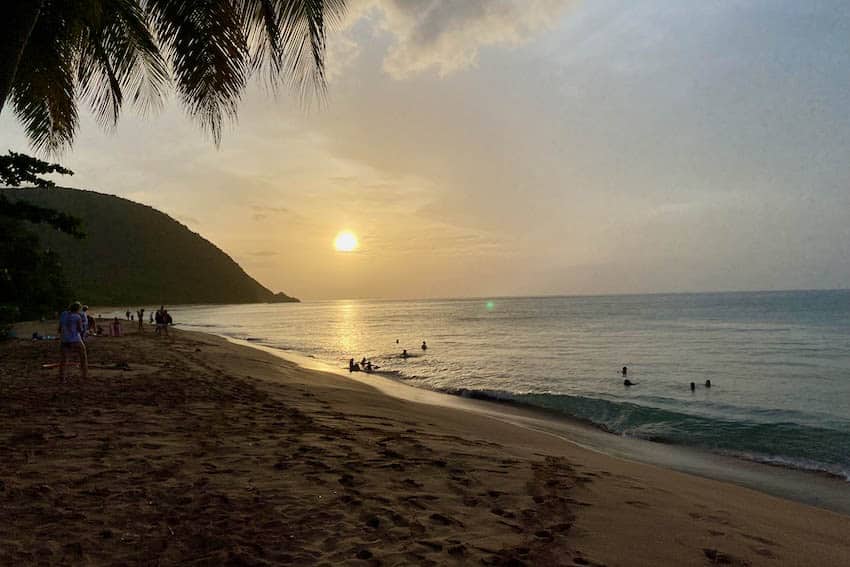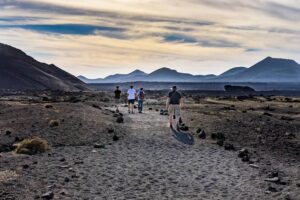
Alone in the Faroe Islands (but not really)
By Karel R. Amaranth
I sank down into the brilliant green grass between a sheer rock cliff and waterfall, sheep grazed nearby and the purportedly rare blue sky filled in between the misted mountaintops.

This was why I was in the Faroe Islands. For about 4 years since I had read a travel article in The New York Times, I had a longing to be in the Faroe Islands that was not altogether rational or describable.
Lying there alone in the grass in the perfect quiet of just the gush of waterfall above and sloshing of the waves in the fjord below, I still didn’t quite know, but I felt why I was there.
Maybe it was because at the 62nd parallel it was the farthest north I have ever been; maybe it was the obscurity and isolation of the islands; maybe their geologic birth as violent volcanoes 55 million years ago when Europe and Greenland drifted apart, and then the shearing of the glaciers that sliced them into 18 separate islands and a myriad of islets and sea stacks.
The Faroe Islands are their own country inside the kingdom of Denmark.
It is still somewhat of a mystery as to why I went to the Faroe Islands, why I feel myself leaning northeast and why I am planning on returning. Kind of like the mystery of falling in love.
Atlantic Air
I flew into Vagar Airport on Atlantic Air, the airline of the Faroe Islands, from Bergen, Norway (about $300 roundtrip,) after a long day in Oslo, and the following day on the stunning fjord to west coast train ride from Oslo to Bergen.

The flight from Bergen to Vagar is a quick one hour up and down, which can be extremely turbulent when the Faroe weather is foggy and windy.
Word has it in the Faroes that you should only fly Atlantic because the pilots only fly to the Faroes and they are the only ones who can fly into the Faroe weather.
My flight was all blue skies and puffy white clouds smooth as silk.
Arriving in Sorvagar
My first night in the Faroes was in Sorvagar, a bed and breakfast (about $85) near the airport and close to the harbor port and ferry to Mykines.
Although I didn’t arrive until after 9:00 PM, in my Citroen rental car, the June night was still light and the light would continue all night.
The B&B host showed me to my room, a large basement room with a shared bathroom through a utility closet; my time there would be very limited since I was leaving on an early ferry to hike on Mykines so the room really didn’t matter.
I had last eaten in Bergen for lunch so I set off on foot into the village of Sorvagar where there were supposedly a few cafes. I was fortunate to find one which was just closing and the owner was willing to make a toasted cheese sandwich for me.
I sat outside, as she closed up, with my sandwich, a beer, and one of the most beautiful twilight views I had ever experienced over the Vagar harbor, Servagsfjordur.
On my walk to the ferry the next morning, I met a young couple from Jersey City, where two of my daughters and their families live. They were the only Americans I would meet on the trip. The ferry was crowded, but a young woman made a space on a bench next to her.

Kate was from Calgary and she and I would spend an absolutely great perfect weather day on Mykines hiking with our guide Harald, who charges 550 DKK, about $75 for his guide services; the ferry is 60 DKK or $8 each way.
The ferry ride to Mykines takes about an hour, sailing past little islands and giant sea stack rock formations. The water here can be rough and we did hit a few swells that sloshed over the bow.
Ferries sometimes are canceled resulting in visitors missing their hikes or having to remain overnight on Mykines which does not have any actual accommodations.
Harald and his wife are known to have stranded visitors in their home overnight or sometimes several overnights.
Harald is delightful and committed to everyone being safe, having fun, and knowing all about the Puffins, Oystercatchers (the national bird of the Faroes,) Arctic terns, Gannets, and various seagulls.

The hike takes about 6 hours round trip up sweeping grass hills, rocky pathways, steps carved into cliff walls, and over a narrow wooden footbridge that connects Mykines with the little sister island of Mykinesholmur through a deep rock crevasse and over swirling water.
Along the way, there are the birds, the vistas of mountains and water, and for us, blue sky.
After the hike back to the harbor and ferry ride, Kate and I drove to a Vagar grocery store where we both stocked up on some food. We said goodbye and planned on meeting when we would both be in Torshavn.
The Island of Bordoy
I then had the approximately 2-hour drive east to Klaksvik on the Island of Bordoy. I was a little anxious about it. I had very little sleep and had been up early to catch the ferry, had hiked for 6 hours and it was after 7:00 PM when we left the grocery store and I got on the road.
Even if it took two hours it would still be light and I had been assured that the roads were good and well paved, and the weather was clear.

I shifted my four on the floor Citroen into first gear, second, third, fourth, and cruised along beautiful Faroe Route 11, and then I got to the tunnel. I have driven through lots of tunnels and I knew there would be tunnels along my route and during my various drives in the Faroes. Areas that once were inaccessible by car because of tall steep mountains or waterways now had tunnels connecting them.
FAROE ISLANDS: UNLIKE ANYPLACE ELSE
So I confidently entered my first Faroe tunnel. It was dark, lit only by my headlights. There was nothing deceptive like extended bathroom tile to distract from the fact that I was driving through a big hole blasted through rock, under a mountain, and then under the Vestmannasund between Vagar and Streymoy Islands.

A few headlights came toward me, passed, and then disappeared into the darkness.
Driving alone through the mountains, cliffs, waterfalls, along the fjords, I had to structure my views and keep my eyes literally on the road.
It took me more than two hours, but it was light and still blue sky when I approached the tunnel that connects Streymoy and Bordoy.
I knew the light would be there at the end of the tunnel and in fact, there was not only light but the lovely town of Klaksvik.
My first day in Klaksvik was the only rainy day of my seven-day trip. I contented myself with a walk around the harbor, and a stop at the R (abbreviation of Rusdrekkasola Landsins) a huge modern, very expensive well-stocked liquor store, the grocery store for gravlax, bread and Foroya beer for dinner, and a foray into what has now become my international tradition, the local thrift store.
Hand Knit Faroe Sweaters
I had been very successful in Ireland, Iceland, and Norway in procuring hand knit traditional sweaters and the Klaksvik thrift shop did not disappoint. Margreth helped me try on three lovely traditional Faroese sweaters that still maintain a mild sheep smell; the cost for all three, 250 Faroese Kroner (about $33 US.)
I also took a drive down the one southbound Bordoy road to Nordoyri, a small settlement of houses. On the way back to Klaksvik I stopped in a forest of young pines that had been planted called Vioarlundin uti I Grov. Trees are almost non-existent in the Faroes because the topsoil is only about 2 feet deep over the volcanic rock.
I wandered through this area in the light rain with the scent of pine, crossing a plank bridge over a waterfall, sitting on a bench with a view of the Bordoyervik bay, the mountains, and a cemetery.

The following day was again bright sunny, blue sky and I set off early toward Hvannasund on the island of Vidoy to take the ferry out to the far easterly islands of Svinoy and Fugloy. I knew there were two tunnels along the way.
What I did not know until I drove into the first one was that these tunnels were two way, one lane. My heart practically stopped as headlights came toward me and then veered off to the left.
I realized that the oncoming traffic had pull-offs and they were responsible (hopefully) for pulling over to allow cars to go past them.
By the time I reached the other side of the tunnel, I was seriously unnerved and…there was another tunnel ahead. I decided that the only way for me to get through another tunnel like this was to have another car ahead of me, so I hovered until a Volvo sedan like my own at home, drove past me and then I stuck behind it all the way through. This strategy got me back through these tunnels on my return trip.

The Buttercup Trail to Muli
I was early for the ferry so I drove out the “Buttercup Trail” to the settlement of Muli, a small cluster of abandoned houses and cottages.
Driving along this road I not only stopped several times to look up at the cliffs and across the water to the island of Vidoy, but slowed to let a gaggle of geese cross the road and give sheep time to saunter off to the grassy shoulders.
I found myself singing Cat Stevens’ “Miles from nowhere, not a soul in sight, oh yeah, but I’m all right.”
I returned to Hvannasund as the ferry captain and crew arrived (they invited me to join them in the cockpit,) and a few other passengers embarked. We navigated through the channel toward Svinoy surrounded by the cliffs and waterfalls pouring to the sea.
The ferry is a great tourist bargain, public transportation that costs 40 Faroese Kroner roundtrip (about $5.50 US.)
Arriving back in Klaksvik I found that only the Angus Steak House was still open for dinner. The steak was good enough and the Foroya beer was brewed right across the street.
The wait staff and other guests were fun, all from the Faroes, and we all had a good time talking about where we were from and where we were going. None of us would be driving so the golden Foroya kept flowing.
I had two days left of my trip and headed to Torshavn where I had a reservation at a B&B. I had been told that it would take less than an hour to get there so I decided to drive to the north end of Streymoy to the village of Saksun.
The road to Saksun is another Buttercup Trail through the mountains, which in this area are clearly volcanic with prominent peaks and cones, all green and waterfalled.
In Saksun, which consists of a few private homes and a traditional turf-roofed church (1858) and cemetery, the mountains drop to an almost fully enclosed bay that fills at high tide and empties at low tide.
I arrived at what seemed mid tide, a wide apron of sand still around the water so I climbed down a rocky hillside confident that there would be a walkway or path coming back up; there wasn’t, so with the water, reflecting the blue sky and clouds, rising, I scrambled back up getting very muddy, sandy and wet.

On the drive back along the Buttercup Trail I decided to pull over and just lay down in the grass and as much as possible absorb the Faroes, the earth and rock beneath me, the sky, the mountains, the waterfall splashing behind me, the bird and sheep smell of the air, the breeze, the buttercups.
I wondered how I could hold onto this place, but as with any travel, I finally had to get up, climb back into the Citroen and move on. The move on however in the Faroes continues to be breathtakingly spectacular along the east coast of Streymoy climbing up steep cliffs overlooking the Tangafjordur and the opposite cliffs of Esturoy.
Torshavn
Torshavn is a lovely town with its bustling harbor of commercial and private boats, restaurants, and elegant shops, including a lovely and well-stocked bookstore, H.N. Jacobsen’s where I was able to buy a copy of The Little Prince in Faroese. The next morning I met Kate at a café for brunch and we shared our adventures.
I decided to pass up the sailboat trip and I took the opportunity to meet up with the very nice man from Torshavn I had met the evening before who took me driving up through some of the highest mountains in the Faroes, up beyond the green grass where the peaks literally pierce the clouds, down to the churches of Kirkjubaur and along the cliffs across from the island of Nolsoy.
It was the perfect last day before I had to drive back to Vagar into that tunnel that was no longer so frightening, a quick stop at Servagsvath, the elevated lake, to once more sit in the grass and buttercups, gaze at the mountains and nuzzle a sheep or two. I dropped off the Citroen and had one last Foroya beer in the airport before my return flight to Norway.
As I knew when I lay down in the grass along the Buttercup Trail from Saksun, I couldn’t hold on to that moment of being there, but I continue to be drawn back to the Faroes. It’s mysterious, kind of like falling in love.
Find out more about the Faroe Islands: Tourism website

Karel R. Amaranth lives in the lovely little village of Piermont on the Hudson River in New York state; she is a public health professional with a wanderlust that has taken her to many wonderful places including Nepal, India, Uganda, Burundi, Scandinavia, and most recently to the Faroe Islands.
- These 9 U.S. National Parks Require Reservations in 2024 - April 17, 2024
- Take a Hike in Olympic National Park - April 17, 2024
- The Wild Mississippi: 2340 Miles Across Ten States - April 8, 2024





